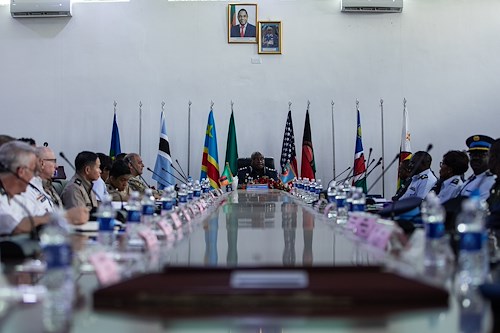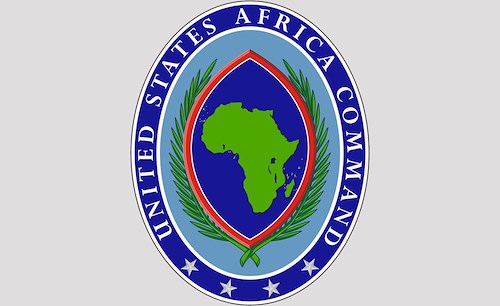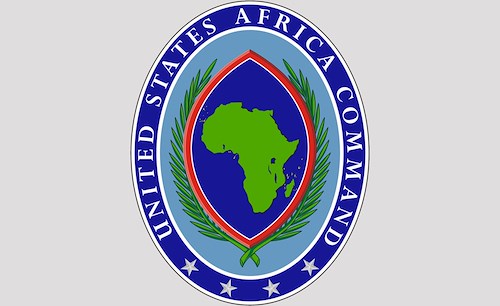“I looked back at the woman who had fallen, a total stranger just moments ago, to see her face covered with tears; her hand still reaching out to try and save me as I was dragged by my ankles outside the mosque. She was surrounded by three angry, armed men. The doors closed behind me. Then I heard the sound of a single shot.”- Amanda Lindhout
Some stories are hard to hear; even those with a happy ending. This is one of those stories.
As part of U.S. Africa Command’s guest speaker series, Amanda Lindhout was invited to share her story, “Freedom in Forgiveness,” in which she recounted how the vision for the charitable organization she founded, the Global Enrichment Foundation, was born during her darkest days as a captive, held for ransom by a group of teenage boys in Somalia.
During her presentation at the Kelley Theater on March 4, Amanda spoke to a packed house – and you really could hear a pin drop during the telling of a story that kept the audience riveted to the edge of their seats.
Eighteen years earlier, Amanda was an eight-year old whose greatest adventure in life was collecting tossed out copies of National Geographic in her home town of Red Deer, Alberta. The photos that captured exotic places, people and cultures around the world inspired this young girl to dream of her own travels far from the Rockies of Western Canada.
Her story was not the one she started out to write. As a journalist, Amanda traveled to Somalia to report on the plight of starving refugees, and to meet Dr. Hawa Abdi, a Somali human rights activist and physician who established a clinic in 1983 just outside Mogadishu, on land owned by her family. The small clinic evolved into a hospital, and later on eventually grew into a camp where Somalis have sought refuge from decades of internal wars. Here, Dr. Abdi, a 2012 Nobel Prize nominee, provides care for more than 90,000 internally displaced persons (IDPs.)
Instead, the story Amanda told was one in which she became the central character; a story of terror and torture, but also one of resiliency and how forgiveness can be the catalyst for positive change.
To describe her as a determined young woman would be an understatement. Early in life she had a vision and she worked hard to realize her dreams.
At 19, after saving tip-money from waitressing, she made her first trek to Venezuela. She soon developed a pattern of returning home to make more money to fund more trips – to Guatemala, Thailand, then on to the continent of Africa. Here, Amanda met someone who was doing what she wanted to do. Nigel Brennan was a freelance photojournalist from Australia and he was living the dream. Seeing his work, Amanda became determined to learn how to document her travels through photography and turn the stories she wanted to write about into a career.
A brief romance blossomed, but ended a short while later. A future adventure would reunite Amanda and Nigel in what has been called one of the most dangerous places on earth.
She ventured on to India and Pakistan, and since “it was right next door,” as she would later say, she traveled to Afghanistan. It was here that Amanda’s first story was published. A brief tour in Afghanistan was followed by another one covering the war in Iraq as a television reporter.
In Iraq, Amanda felt a need to move on – to go exactly where she really wanted to be, to report on the stories she felt no one else was telling.
That place was Somalia, and an unexpected email from Nigel resulted in the two of them making what was planned to be a seven-day trip to capture the story of the thousands of IDPs at the camp outside Mogadishu.
In Somalia, humanity amidst meager means
“People were lined up for ten hours in the hot sun to receive just a small serving of food. No one was telling this story,” said Amanda. “I began talking to people. And they wanted to talk. Out of my peripheral vision, I could see a young woman holding an emaciated child in her arms. I could see that she wanted to talk to me, so I turned toward her. Looking directly at me, she held out a red plastic bucket into which she’d just been given about two scoops of porridge, and she said to me, ‘Are you hungry?’ ”
Amanda Lindhout is the stereotype of what you’d imagine a young, adventurous girl from the rugged Rocky Mountains of Canada to be. Tall, poised, with expressive eyes, she’s the girl next door who also knows how to take care of herself – she exudes that kind of confidence.
Her outward appeal is obvious. But her story portrays one of inner beauty – one characterized by strength, resiliency, and faith in humanity – in all its forms.
“The face of that young mother offering me, a total stranger, her food, even as she held her hungry child in her arms, told me I had come to a place where people with the most meager of means have humanity,” said Amanda. “This is the story I was passionate about because it needed to be told.”
“The end of my life as I knew it”
“On the fourth day of our trip, we set out with our driver and security from our hotel in Mogadishu. There aren’t many cars in this city. As we were flying into Mogadishu, this place looked like an unspoiled paradise, with white sandy beaches along the sparkling aquamarine of the Indian Ocean. But when we got on the ground, it was as I’d heard. The streets were empty of regular people because they feared going outdoors. On the streets were mostly groups of young men, all of them with guns,” she said.
“But you didn’t see many cars, so when we did see one that morning after we left our hotel, we noticed it. It was moving slow and we saw several men, all with guns, come from behind the car and toward us. Before I knew it, we were pulled out of our car and forced face down to the ground, guns to the backs of our heads. It was terrifying,” she said. “Just as quickly, we were shoved back into our car, this time with our captors at the wheel, and were driven an hour into the dessert, past the very camp Nigel and I were headed to that morning. No one told us where we were going. But I realized it was the end of my life as I knew it.”
Amanda’s ordeal of captivity is the stuff made of nightmares. Brutal, but not without moments of humanity. The daring escape she and Nigel made to reclaim their freedom ended inside a crowded Mosque full of praying men.
“Nigel and I could hear the call to prayers. Our plan was to seek help at the mosque. Running inside, with our captors on our heels, the scene was total chaos. Some of the men seemed to want to help us.”
Amanda, who had not seen another woman for the five months she had been a captive, said one brave woman, dressed in a burka with only her eyes visible, burst from the shadows, rushed toward her and, speaking in English, called her, “Sister!”
“She covered me and I just clung to her. She begged the men who were yelling, to free me, to not take me away. She just would not let go of me and I held onto her. They grabbed my ankles and began to drag me away. This woman threw herself on top of me, still begging them to let me go. When she could no longer hold on, she fell onto the floor.
I looked back at her to see that her veil had come off and she was looking right at me. In that moment, I remember thinking that she looked about the age of my own mother. She was crying and reaching toward me. After we got past the doors and outside the mosque, I heard the shot.”
Amanda paused. I supposed she has recounted this so many times by now, that she’s come to realize that those listening need that pause.
It’s a hard story to hear.
In the The Dark House, a vision to help others is born
“Things got much worse for us after our attempt to escape. We were moved to yet another house, all of which we named, but this one was the worse. I called it, ‘The Dark House,’ ” said Amanda.
She told the audience that what she had come to fear most, more than the physical brutality, pain and malnutrition she was suffering, was losing her mind. But in a pivotal moment, when she said she felt she was approaching the abyss, her mind did take a turn, but it was toward a place of light, of hope. And then she made a plan.
“I made a conscious choice to not give up. I took that little tiny seed of hope and nurtured it. I thought of Nelson Mandela. I thought of home, my country, my family. I knew my mom was working around the clock to gain my freedom, negotiating directly with our captors for our lives. I thought of my travels to beautiful places. And I thought of the woman at the mosque, a total stranger, who, without hesitation, may have given her life for someone she’d never known. I began to see humanity all around me.
“In The Dark House, I also envisioned another house, one I called, ‘A House in the Sky.’ It became my safe haven, a place I could take myself to during my captivity to escape the pain.
“I made a plan that if I survived I was going to work to bring positive change in Somalia. In this house is where the vision for what would later become the Global Enrichment Foundation was born,” said Amanda.
Through immense resilience, and due primarily to the untiring efforts of her mother, Amanda and Nigel were eventually freed after 460 days in captivity. She’s since written a memoir entitled, “A House in the Sky.”
The Global Enrichment Foundation becomes reality
“I was never so happy to see the Canadian flag,” said Amanda, when her plane touched down in her homeland after leaving the hospital in Kenya.
“It took about a month for me to really grasp that I was indeed free again. I was still healing, and exploring all my emotions; it was hard to not feel anger, especially at myself for what I’d put my family through. So I found myself at another decision point and chose to move ahead with my vision to help the people of Somalia.”
She founded The Global Enrichment Foundation a few months after her release. Its goal is to provide scholarships to 100 young Somalia women each year. There is a large Somali population not far from Amanda, and because her story made headline news for weeks in Canada, she received an enthusiastic and warm welcome from the Somali community when she returned home.
“I was overwhelmed by how they made me feel. It was such a wonderful way to be welcomed home,” said Amanda. This community of Somalis is where Amanda was able to connect to people who would help her bring her vision to life.
“Education at a young age is key,” said Amanda. “Some of the boys who held me captive told me of their dreams to go to school. They wanted more for themselves. There is no justifying what they did even though these were teenage boys, not grown men. But I could see they had scars. Many were orphans and had witnessed members of their own families killed. I could, in some way, understand that they wanted to make someone else hurt more than they had been hurt. But they were fed a steady diet of radical teachings. Within a few months of my captivity, many of them had become radicalized; they didn’t dream of school anymore. They wanted to be suicide bombers. Their bosses, who came by from time to time, were dressed in nice suits and wore cologne.
“This made me aware. Once you become aware of a problem, then you have a responsibility to do something about it. I believe that providing educational opportunities to young women, to help them learn leadership, well, it makes perfect sense,” said Amanda. “Helping to make education possible for those who can become leaders in Somalia was the perfect response to what had happened to me.”
The next chapter
After her presentation, Amanda agreed to answer a few questions from me.
Q: Many have the perception that trying to do any “good works,” particularly in Somalia, is an exercise in futility. What would you like for us to know about the people of Somalia?
Amanda: They are a very proud people, and are truly hopeful for their future. They know it’s a hard road ahead, but they are deeply committed to making things better.
Q: You’re now being sought after as a frequent speaker on the subject of forgiveness. In a world where so many seek revenge, why do you think your message has such broad appeal?
Amanda: When I returned home, people began asking me to come speak at different events. I wanted to make people aware of the GEF so that was all I talked about. I did not want to recount anything about my ordeal in Somalia. But what I found is that people would always ask what led me to establish the GEF, well, then, I had to tell them. I realized I had to include this in my story and when I did, the way in which people responded was overwhelming.
We all have something to forgive. Much of the time, that includes forgiving ourselves. Most people have learned that if you can’t forgive, you are still allowing yourself to be held captive by that hurt, that pain you suffered. And I can say with 100% certainty that there really is freedom in forgiveness. It’s not easy by any means, but forgiving has allowed me to focus on moving ahead with my vision to help young women in Somalia to have a chance for a better future.
Q: Did you ever get to meet Dr. Abdi?
Amanda: Yes! What an amazing woman. It was hard for me to go back to Somalia, but her work is so important; I wanted to help. I was able to talk with her and I asked her to make a list of everything she needed. She did and I can tell you that if you don’t think one person can make a difference, then you should hear what Dr. Hawa Abdi has done for her people – and for over 20 years now. We’ve been able to leverage fundraising through the GEF, and go beyond providing scholarships; we’ve been able to help Dr. Abdi get what she’s asked to help tens of thousands of people at the IPD camp.
Q: What’s next for you?
Amanda: “I’m planning to attend university in the Fall to study psychology. And, I’m thinking about writing another book, this one on the subject of recovery.”




